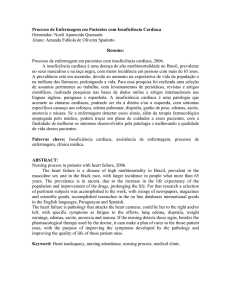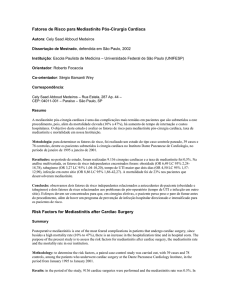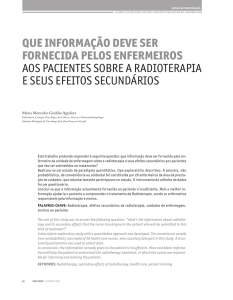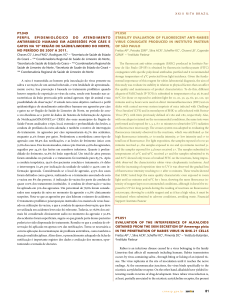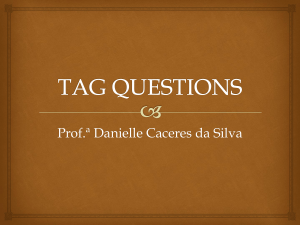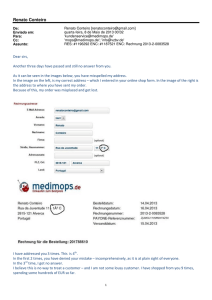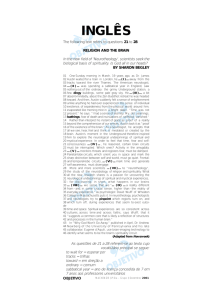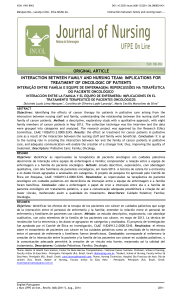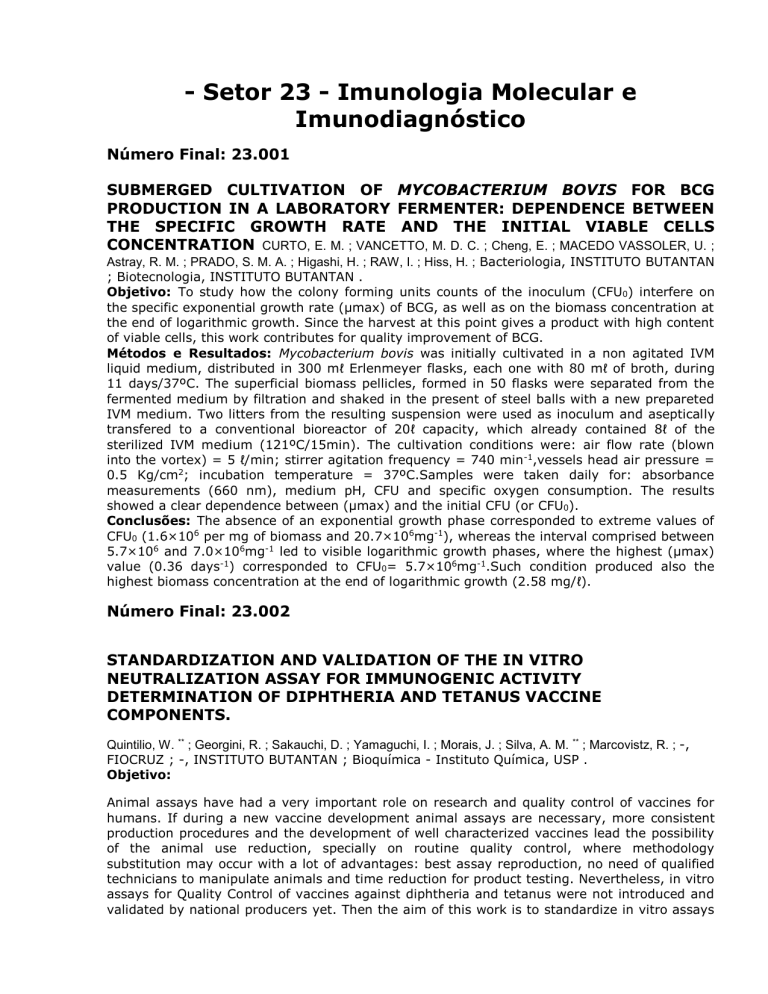
- Setor 23 - Imunologia Molecular e
Imunodiagnóstico
Número Final: 23.001
SUBMERGED CULTIVATION OF MYCOBACTERIUM BOVIS FOR BCG
PRODUCTION IN A LABORATORY FERMENTER: DEPENDENCE BETWEEN
THE SPECIFIC GROWTH RATE AND THE INITIAL VIABLE CELLS
CONCENTRATION CURTO, E. M. ; VANCETTO, M. D. C. ; Cheng, E. ; MACEDO VASSOLER, U. ;
Astray, R. M. ; PRADO, S. M. A. ; Higashi, H. ; RAW, I. ; Hiss, H. ; Bacteriologia, INSTITUTO BUTANTAN
; Biotecnologia, INSTITUTO BUTANTAN .
Objetivo: To study how the colony forming units counts of the inoculum (CFU0) interfere on
the specific exponential growth rate (µmax) of BCG, as well as on the biomass concentration at
the end of logarithmic growth. Since the harvest at this point gives a product with high content
of viable cells, this work contributes for quality improvement of BCG.
Métodos e Resultados: Mycobacterium bovis was initially cultivated in a non agitated IVM
liquid medium, distributed in 300 mℓ Erlenmeyer flasks, each one with 80 mℓ of broth, during
11 days/37ºC. The superficial biomass pellicles, formed in 50 flasks were separated from the
fermented medium by filtration and shaked in the present of steel balls with a new prepareted
IVM medium. Two litters from the resulting suspension were used as inoculum and aseptically
transfered to a conventional bioreactor of 20ℓ capacity, which already contained 8ℓ of the
sterilized IVM medium (121ºC/15min). The cultivation conditions were: air flow rate (blown
into the vortex) = 5 ℓ/min; stirrer agitation frequency = 740 min-1,vessels head air pressure =
0.5 Kg/cm2; incubation temperature = 37ºC.Samples were taken daily for: absorbance
measurements (660 nm), medium pH, CFU and specific oxygen consumption. The results
showed a clear dependence between (µmax) and the initial CFU (or CFU0).
Conclusões: The absence of an exponential growth phase corresponded to extreme values of
CFU0 (1.6×106 per mg of biomass and 20.7×106mg-1), whereas the interval comprised between
5.7×106 and 7.0×106mg-1 led to visible logarithmic growth phases, where the highest (µmax)
value (0.36 days-1) corresponded to CFU0= 5.7×106mg-1.Such condition produced also the
highest biomass concentration at the end of logarithmic growth (2.58 mg/ℓ).
Número Final: 23.002
STANDARDIZATION AND VALIDATION OF THE IN VITRO
NEUTRALIZATION ASSAY FOR IMMUNOGENIC ACTIVITY
DETERMINATION OF DIPHTHERIA AND TETANUS VACCINE
COMPONENTS.
Quintilio, W. ** ; Georgini, R. ; Sakauchi, D. ; Yamaguchi, I. ; Morais, J. ; Silva, A. M. ** ; Marcovistz, R. ; -,
FIOCRUZ ; -, INSTITUTO BUTANTAN ; Bioquímica - Instituto Química, USP .
Objetivo:
Animal assays have had a very important role on research and quality control of vaccines for
humans. If during a new vaccine development animal assays are necessary, more consistent
production procedures and the development of well characterized vaccines lead the possibility
of the animal use reduction, specially on routine quality control, where methodology
substitution may occur with a lot of advantages: best assay reproduction, no need of qualified
technicians to manipulate animals and time reduction for product testing. Nevertheless, in vitro
assays for Quality Control of vaccines against diphtheria and tetanus were not introduced and
validated by national producers yet. Then the aim of this work is to standardize in vitro assays
and validate it by comparison with the traditional in vivo assays for the immunogenic activity of
dT and DTP vaccines produced by Butantan Institute.
Métodos e Resultados:
The chosen method was the in vitro neutralization assay (Marcovistz et al., 2002, Biologicals
30:105-112), a modification of the Toxin Binding Inhibition assay (ToBI) published by
Hendriksen (1988, J. Biol Stand. 16: 287-297). Vaccinated guinea pigs were bled 28 and 42
days (for diphtheria and tetanus component respectively) after the vaccine inoculation.
Neutralization reaction was made with the obtained sera and diphtheria or tetanus toxoid. To
determine non neutralized toxoid it was made an ELISA assay.
There were made at least 10 tests on 16 lots for diphtheria component and on 12 lots for
tetanus component, including DTP, DT, dT and diphtheria or tetanus toxoids. For diphtheria
component, 2 analysis shows that the in vitro and the in vivo data were significantly similar,
demonstrating homogeneity and equivalence between these assays. For tetanus component,
the results were similar – correlation coefficient 0,85.
Conclusões:
These results open real perspectives for the in vitro assay introduction on substitution of the
traditional in vivo assays.
Apoio Financeiro: FUND.BUTANTAN , FAPESP , FAPERJ
Número Final: 23.003
DETECÇÃO DA INFECÇÃO ATIVA PELO HERPESVÍRUS HUMANO 7
(HHV-7) EM PACIENTES TRANPLANTADOS HEPÁTICOS. Luis, R. ** ; Sampaio, A.
M. ** ; Bonon, S. H. A. ** ; Costa, S. C. B. ; Boin, I. F. ; Leonardi, L. S. ; Clínica Médica - FCM, UNICAMP ;
Unidade Fígado e Transplante Hepático - FCM, UNICAMP .
Objetivo: O Herpesvírus humano 7 (HHV-7) tem sido descrito como causador de processos
exantemáticos benignos em crianças, mas integra seu material genético (DNA) em células
linfóides, conduzindo a uma infecção latente. No caso de pacientes imunossuprimidos como os
pacientes que receberam transplantes pode se reativar e, em associação com outros
herpesvírus, principalmente o Citomegalovírus Humano (HCMV), causar danos tanto ao órgão
transplantados, como ao estado geral do paciente. O principal objetivo do presente trabalho foi
detectar a infecção ativa pelo HHV-7 em pacientes submetidos a transplantes hepáticos
atendidos no HC - UNICAMP.
Métodos e Resultados: Amostras de DNA de leucócitos totais e de soro foram extraídas a
partir de amostras de sangue coletadas de um grupo controle considerado sadio. Amostras de
DNA foram extraídas de soro obtido a partir do sangue coletado de pacientes submetidos a
transplante hepático no HC-UNICAMP entre os anos de 2000 e 2003. A Reação em Cadeia de
Polimerase (Nested-PCR) foi realizada usando iniciadores (primers) para regiões altamente
conservadas do genoma do HHV-7. Das amostras analisadas no grupo controle (21 amostras) 8
foram positivas para o DNA do HHV-7 extraído de leucócitos totais (38,09%) e nenhuma
amostra (0%) foi positiva no soro. Nas amostras de DNA extraídas de soro dos pacientes
transplantados (46 amostras) 12 foram positivas ( 26,08%) para o HHV-7.
Conclusões: Nenhuma das amostras do grupo controle que foi positiva no DNA extraído de
leucócitos totais resultou positiva no DNA extraído do soro, sugerindo infecção latente na
população analisada. Nas 46 amostras de DNA extraído do soro dos pacientes transplantados
12 (26,08%) foram positivas, indicando que esses resultados poderiam estar relacionados ao
estado de imunossupressão própria destes pacientes sugerindo que estes, estejam com
infecção ativa (vírus replicante e liberação para fora das células). Os resultados sugerem que a
Reação em Cadeia de Polimerase em amostras de DNA extraídas de soro podem ser úteis para
diferenciar infecção latente de infecção ativa pelo HHV-7. A prevalência de infecção ativa em
pacientes transplantados hepáticos é maior que na população sadia.
Apoio Financeiro: UNICAMP
Número Final: 23.004
DIPHTHERIA TOXOID CONCENTRATIN INFLUENCE ON IMMUNOGENIC
ACTIVITY AND REACTOGENICITY OF DTP VACCINE. Quintilio, W. ** ; Morais, J. ;
Sakauchi, D. ; Takata, C. ; Yamaguchi, I. ; Higashi, H. ; Marcovistz, R. ; -, FIOCRUZ ; -, INSTITUTO
BUTANTAN ; Bacteriologia, INSTITUTO BUTANTAN ; Bioquímica - Instituto Química, USP .
Objetivo:
Combined vaccines against diphtheria tetanus and pertussis are being currently used worldwide
since 40’s and with a coverage over 95% in Brazil (FUNASA, 2002). DTP vaccine formulation
must induce in children a minimum antibody titer of 0.01 IU/mL against tetanus and 0.1 IU/mL
against diphtheria. These values are arbitrary and they were based on animal studies that
established a correlation between antitoxin antibody levels and either the appearance of
symptoms. However for product quality control a minimum antibody titer of 2 IU/mL for
diphtheria or tetanus and 8 IU/mL for pertussis are considered satisfactory. To obtain these
titers the vaccine is formulated with tetanus and diphtheria toxoids at a concentration of
20Lf/mL each. Recently there were reported some cases of diphtheria even in vaccinated
children. This study investigated the effect of diphtheria toxoid concentration effect on the
immunogenic activity and reactogenicity of a DTP vaccine, aiming to rise the immune response
in future clinical studies without any rise on reactogenicity.
Métodos e Resultados:
Five pilot lots of DTP vaccine with different concentrations of diphtheria toxoid (24, 30 and 40 Lf/mL) were
tested in terms of immunogenic activity and specific toxicity for the three components. Formulations were
assayed as the usual procedure of quality control: for pertussis component, groups of mice were immunized
with three serial dilutions and a challenge was made fourteen days after with B. pertussis. For diphtheria and
tetanus components, guinea pigs received a half of the total human dose and after the immune response
development period they were bled and sera were titred. Pertussis specific toxicity was assayed by mice
weight gain test. Diphtheria and tetanus components toxicity was determined on guinea pigs. All of the
experimental lots resulted atoxic for the three components and the immunogenic activity was above the
minimum established limit.
Conclusões:
These results suggest that an augmentation of the diphtheria component concentration may be
done without any loss of activity neither rise on toxic effects.
Apoio Financeiro: FUND.BUTANTAN
Número Final: 23.005
SEROLOGICAL DIAGNOSIS OF VISCERAL LEISHMANIASIS BY AN
ENZYME IMMUNOASSAY USING PROTEIN A IN NATURALLY INFECTED
DOGS Lima, V. M. F. de ; Silva Dossi, A. C. ** ; Biazzono, L. ; Cecília Rui Luvizotto, M. ; Clínica, UNESP -
Araçatuba ; Clínica e Cirurgia, UNESP - Araçatuba ; Patologia Veterinária, UNESP - Araçatuba .
Objetivo: Leishmaniasis is a disease caused by a Leishmania protozoa. This disease has great
importance in public health because dogs are the domestic reservoirs. These protozoa can
cause self-healing diseases and lethal visceral leishmaniasis. Infected dogs may develop a
severe syndrome characterized by chronic evolution of viscerocutaneous signs, which result
from Leishmania multiplication in macrophages of spleen, liver, bone marrow, lymph nodes and
skin. Most of the infected animals are susceptible and develop active disease, a chronic, not
self-healing visceral disease, which is characterized by high anti-Leishmania antibody titers and
depressed lymphoproliferative abilities. ELISA is a useful method of diagnosis because of its
high sensitivity and specificity. Symptomatic mixed breed dogs from a region of high incidence
of visceral leishmaniasis in Brazil were examined for the presence of antibodies against whole
antigen using peroxidase conjugate of either protein A or anti-IgG from S. aureus in ELISA
assay. The presence of cross-reaction between L. (L.) chagasi whole antigen and serum from
dogs from areas non-endemic for Leishmaniasis and infected with Toxoplasma gondii (6),
Ehrlichia canis (15) and Babesia canis (10) and Dirophilaria immitis (19) was also investigated
in both systems.
Métodos e Resultados: The results showed that protein A ELISA system is more sensitive
than anti-IgG to detect positive animals. In direct comparison with anti-immunoglobulin
conjugate, enzyme-linked protein A resulted in higher absorbance values for positive sera
without a corresponding increase in absorbance values for sera from non infected dogs. The
effect was an increase in the distance between positive and negative values, which aided in the
interpretation of the results. In addition, no cross-reaction occurred between L. (L.) chagasi
whole antigen and serum tested. The higher optical density values observed in the ELISA assay
with the use of protein A could be related to the detection not only of IgG, but also of IgM and
IgA.
Conclusões: These results suggest that ELISA assay using protein A to detect positive animals
can be useful to diagnose visceral canine leishmaniasis in early infected animals in endemic
areas, and thus help to control the spread of infection.
Apoio Financeiro: FUNDUNESP
Número Final: 23.006
HELICOBACTER PYLORI EM PACIENTES COM ÚLCERA E GASTRITE:
DETECÇÃO PELA PCR E GENOTIPAGEM PELO GENE UREASE C Roesler, B. M. **
; Mendonça Ferreira Menoni, S. ; Bonon, S. H. A. ** ; Robilotta Zeitune, J. M. ; Costa, S. C. B. ; Clínica
Médica - FCM, UNICAMP .
Objetivo: Padronizar e implantar uma técnica rápida e de grande sensibilidade para a detecção
do patógeno Helicobacter pylori, a Reação em Cadeia da Polimerase, em amostras de biópsias
gástricas obtidas através de exame endoscópico (biópsias a fresco). Determinar o genótipo de
cepas de H. pylori utilizando-se enzimas de restrição específicas no fragmento do gene urease
C amplificado pela PCR.
Métodos e Resultados: Os métodos utilizados para a detecção da H.pylori nas amostras de
biopsias gástricas dos pacientes portadores de úlcera e gastrite foram: extração de DNA das
biopsias a fresco; confirmação da presença de DNA e de sua qualidade nas amostras pela
reação de betaglobina; amplificação gênica pela reação em cadeia da polimerase para detecção
da bactéria na região do gene da urease C; finalmente, nas amostras positivas, digestão com
enzimas de restrição específicas para o gene da urease C. Resultados: Resultados preliminares
foram obtidos utilizando-se 82 amostras de biópsias a fresco sabidamente positivas para H.
pylori (histologia), nas quais foi realizada a PCR, obtendo-se 100% de concordância. A
genotipagem foi realizada com as enzimas de restrição Hha I e Mbo I.
Conclusões: Os resultados demonstraram que a PCR é uma técnica de grande
reprodutibilidade. Para a genotipagem, foram utilizadas 58 amostras, com duas enzimas de
restrição: Hha I e Mbo I. Foram encontrados 11 padrões com a enzima Hha I (18,9%)e 12
padrões com a enzima Mbo I (20,7%).
Número Final: 23.007
EVALUATION OF LOW TETANUS OR DIPHTHERIA ANTITOXIN TITRES IN
SERA BY TOXIN NEUTRALIZATION ASSAY AND A MODIFIED TOXIN
BINDING INHIBITION TEST. Sonobe, M. ; Trezena, A. G. ; Guilhen, F. B. ; Takano, V. ;
Fratelli, F. ; Sakauchi, D. ; Morais, J. ; PRADO, S. M. A. ; Higashi, H. ; -, BUTANTAN ; Bacteriologia,
BUTANTAN ; -, INSTITUTO BUTANTAN ; Bacteriologia, INSTITUTO BUTANTAN ; Sorologia,
INSTITUTO BUTANTAN .
Objetivo: A method for screening of tetanus and diphtheria antibodies in sera utilizing
anatoxin instead of toxin was developed as alternative to the in vivo toxin neutralization assay
based on toxin binding inhibition test (TOBI-test). In this study, the titres in sera of immunized
guinea pigs measured by TOBI-test and toxin neutralization assays were correlated.
Métodos e Resultados: Titres of tetanus or diphtheria antibodies were evaluated in sera
samples of guinea-pig immunized with tetanus toxoid or Triple vaccine. For TOBI-test, after
blocking the microtitre plates, the standard tetanus or diphtheria antitoxin and different
concentrations of the guinea pig sera were incubated with the respective anatoxin. The next
day, these samples were transferred to a plate previously coated with tetanus or diphtheria
antitoxin in order to bind the remaining anatoxin. This anatoxin was then detected using a
peroxidase-labelled tetanus or diphtheria antitoxin. The titres of the sera were calculated using
a linear regression plot of the results of the correspondent standard antitoxin. For toxin
neutralization assay, L+/10/50 doses of either toxin combined with different concentrations of
sera samples were inoculated in mice. The titre was calculated as the highest dilution of sera in
which 50% of the animals survived. Both assays were suitable to determine wide range of
antitoxin levels. The linear regression plots of the results showed higher correlation coefficient
for tetanus (0.97) than for diphtheria (0.82) between the in vitro and the in vivo assays.
Conclusões: The standardized method is appropriate to evaluate titres of neutralizing
antibodies making possible the in vitro control of antitoxins levels of sera.
Apoio Financeiro: FUND.BUTANTAN
Número Final: 23.008
COMPARISON OF BIOMASS PRODUCTIVITY BETWEEN TWO CULTURE
MEDIA, FOR THE PRODUCTION OF BCG, BY SUBMERGED CULTIVATION:
VARIATION OF THE INITIAL GLYCEROL CONCENTRATION VANCETTO, M. D.
C. ; CURTO, E. M. ; Astray, R. M. ; MACEDO VASSOLER, U. ; Cheng, E. ; PRADO, S. M. A. ; Higashi, H. ;
Hiss, H. ; Bacteriologia, INSTITUTO BUTANTAN .
Objetivo: To verify which of the two culture media (IVM or Sauton), led to the highest biomass
productivity of Mycobacterium bovis, studying in addition the influence of the initial glycerol
concentration in both media, on the mentioned productivity.
Métodos e Resultados: Mycobacterium bovis was cultivated, without surfactant (at 37ºC/8
days) on the surfaces of both non agitated liquid media in 300 mL Erlenmeyer flasks, each one
with 80 mL of IVM or Sauton medium. After separation of the bacterial pellicles from the
fermented media by filtration, the cells were shaken in the presence of steel balls, and their
respective new prepared medium. The two resulting suspensions were used to inoculate two
series of flasks (with 60 mL of medium), agitated in a rotary shaker at 37ºC/14 days at 180
min-1. Samples were daily taken from the shaker, which corresponded to the whole content of a
flask, for measurements of: optical density, pH and CFU (colony forming units). The glycerol
concentration of 30 and 60 mL/L led to the highest biomass productivity, namely 0.51g/Kg x
day in Sauton medium and 1.61g/Kg x day in IVM medium, respectively. In a like fashion, the
highest productivity, in terms of CFU variation (ΔCFU), was reached with the IVM medium,
containing 60 mL/L glycerol, both with 7 and with 14 days cultivation. Such production however
decreased between 7 (ΔCFU = 3.36mg-1) and 14 days (ΔCFU = 2.15mg-1), indicating that an
excessive surpassing of 7 days cultivation period was not advisable, for a further
immunotherapic product processing. The Sauton medium presented viability losses instead of
increases, revealed by the negative values encountered for ΔCFU.
Conclusões: The glycerol concentration of 60 mL/L in IVM medium led to the highest biomass
and CFU productivities. The raw-material reduction was considerable when compared with the
static cultivation: about 88%.
Número Final: 23.009
ESTUDO IMUNOFENOTÍPICO DE LEUCEMIA LINFOBLÁSTICA AGUDA
(LLA) Oliveira, A. de A. * ; Silva, B. D. R. A. * ; Ribeiro, A. S. * ; Gomes, B. E. ; Wagner-Souza, K. ;
Diamond, H. R. ; Souza, M. H. F. O. de ; Imunologia, INCa-RJ ; Patologia Geral e Laboratórios, UERJ
.
Objetivo: A LLA é caracterizada pelo acúmulo de precursores linfóides na medula óssea (MO)
em detrimento dos outros componentes da hematopoese normal. Ela pode ser subdividida de
acordo com a linhagem de precursores que a originou: LLA-T (linhagem T), LLA-B (linhagem B)
ou bifenotípica (origem T e B e/ou linfóide e mielóide). O objetivo deste trabalho foi o estudo
imunofenotípico de pacientes com LLA mostrando os marcadores comuns e aberrantes de cada
subtipo, relacionando com dados da literatura.
Métodos e Resultados: Entre março/2003 e março/2004 foram estudadas amostras de MO
de 36 pacientes de vários hospitais da rede pública, sendo 15 do sexo masculino e 21 do
feminino. Havia 3 com menos de 1 ano, 17 entre 1 e 10 anos e 16 entre 11 e 24 anos. As
amostras foram marcadas com um painel de anticorpos monoclonais sendo adquiridas e
analisadas no citômetro de fluxo. A incidência da LLA-B foi de 66,7%, de LLA-T 16,7% e de
bifenotípica 16,7%. O CD19 estava presente em 91,7% dos casos de LLA-B, o CD10 em
83,3%, CD22 em 70,8%, CD20 em 29,2%, sendo rara a presença de marcadores aberrantes.
Todos os casos de LLA-T foram reativos ao CD3 intracitoplasmático e 83,3% ao CD7, os
marcadores aberrantes mais comuns foram: CD10 (33,3%), CD19 (16,7%), CD13 (33,3%) e
CD33 (16,7%). Entre os casos de LLA-bifenotípica, os marcadores mais comuns da linhagem B
foram: CD19 (100% dos casos); da linhagem mielóide: CD33 e CD13 (ambos, 33,3%); e da
linhagem T: CD3 (66,7%) e CD7 (83,3%).
Conclusões: Conforme esperado, houve um predomínio de LLA-B, porém com incidência
menor do que na literatura (75% a 85%), provavelmente devido ao aumento da ocorrência de
bifenotípica, que neste trabalho teve a mesma incidência de LLA-T, 16,7% contra 4% na
literatura. Esta discrepância pode ser associada ao pequeno tamanho da amostra e
possivelmente a algum fenômeno sazonal. Os imunofenótipos encontrados para cada subtipo
estão de acordo com o esperado: na LLA-B o CD19 é o marcador mais comum; na LLA-T, o
CD3; e na bifenotípica ocorreu a presença de marcadores de mais de uma linhagem.
Apoio Financeiro: CNPq , UERJ , MINISTÉRIO DA SAÚDE
Número Final: 23.010
CORRELAÇÀO
ENTRE
AS
CARACTERÍSTICAS
CLÍNICAS
E
CITOGENÉTICAS EM PACIENTES COM LEUCEMIA MIELÓIDE CRÔNICA
TRATADOS COM MESILATO DE IMATINIBE Alvarenga, T. F. * ; Otelo, L. ; Tavares, R. de
C. ; Dobbin, J. ; Lucena, S. ; F. Ornellas, M. H. ; Fernandez, T. ; -, INCa-RJ ; -, UERJ ; Patologia Geral e
Laboratórios, UERJ ; Patologia Geral e Laboratórios, Universidade do Estado do Rio de Janeiro .
Objetivo: A leucemia mielóide crônica (LMC) é caracterizada citogeneticamente pelo
cromossomo Philadelphia (Ph), resultante da translocação 9;22, ocorrendo a fusão dos genes
bcr-abl. Os tratamentos disponíveis são o transplante de medula óssea alogenêico (TMO),
a-interferon e o mesilato de imatinibe. O mesilato de imatinibe é uma nova expectativa de cura
por inibir potentemente a tirosina-quinase BCR-ABL e conseqüentemente a proliferação celular,
sendo alvo-molecular específico. Este trabalho possui o objetivo de correlacionar as
características clínicas e citogenéticas com a resposta ao tratamento com mesilato de
imatinibe.
Métodos e Resultados: Foram estudados clinicamente e citogeneticamente 39 pacientes
tratados com mesilato de imatinibe, no período de janeiro/2001 até março/2004. Para a análise
citogenética foram incubadas células de medula óssea durante 24h sem estimulação. A análise
cromossômica foi feita pela técnica de bandeamento G, seguindo os critérios adotados pelo
ISCN (1995). O estudo clínico foi realizado através de levantamento dos prontuários dos
pacientes. Dos 39 pacientes analisados citogeneticamente 30 pacientes (77%) apresentaram o
cromossomo Ph como alteração cromossômica única, enquanto 9 (23%) apresentaram
alterações cromossômicas adicionais. Do total dos pacientes estudados, 27 (69%)
apresentaram resposta citogenética, sendo que 10 (37%) destes pacientes apresentaram
resposta citogenética total, negativando a presença do cromossomo Ph e se encontram
assintomáticos. Durante o tratamento, os principais sintomas clínicos observados foram:
diarréia, náuseas e edema.
Conclusões: O tratamento com mesilato de imatinibe foi bem tolerado clinicamente. A
correlação das características clínicas e citogenéticas mostrou que a maioria dos pacientes que
não apresentaram resposta clínica e citogenética, possuiam alterações cromossômicas
adicionais. Nossos resultados sugerem que a análise citogenética é fundamental no diagnóstico
podendo selecionar os pacientes com LMC para tratamentos específicos, permanecendo como
método padrão para o diagnóstico e acompanhamento dos efeitos da terapia.
Apoio Financeiro: INca-RJ
Número Final: 23.011
ALTERNATIVE
METHODOLOGY
FOR
THE
EUTECTIC
POINT
MEASUREMENT OF A BCG SUSPENSION PRADO, S. M. A. ; PRADO, J. A. D. ; OLIVEIRA,
S. D. ; CURTO, E. M. ; Guilhen, F. B. ; VANCETTO, M. D. C. ; Higashi, H. ; Hiss, H. ; FIOCRUZ, FIOCRUZ
; Bacteriologia, INSTITUTO BUTANTAN .
Objetivo: To standardize a simplified methodology for the eutectic point determination of M.
bovis suspensions and to recommend a temperature for freezing BCG lots before ice
sublimation
Métodos e Resultados: M. bovis was diluted to a concentration of 27mg/mL in six different
protective solutions for lyophilization. The tests were performed in a ThermoSavant (RC
300-200) lyophilizer, with three shelves. Each test was carried out in duplicate from samples of
the same starting material for lyophilization, which were placed on two shelves of the
lyophilizer. On another shelf was placed a 10% sodium chloride solution as the control (eutectic
point = -21.3°C). A temperature drop was then verified until a minimum of about -50°C. When
the temperature product approximated 3°C, the values were registered at each minute, until
-2°C to -4°C. At this moment the temperature returned to 0°C. Afterwards a drop from 0°C to
-10°C was observed, since the energy was transferred to the system as a consequence of the
change in state. From this value the measurements were again registered at each minute until
the moment where a new heat transfer from the system to the product took place. This
temperature was considered the eutectic point. Six values of the control resulted in an average
of -21.4°C and a variation coefficient of Cv = 0.66%, which represents a good
reproductiveness. The protective solutions presented the following eutectic points: solution 1
(-26.7°C and -26.5°C); 2 (-24.2°C and -24.2°C); 3 (-25.3°C and -25.2°C); 4 (-25.2°C and
-25.3°C); 5 (-23.1°C and -23.2°C); 6 (-24.2°C and -24.1°C).
Conclusões: Taking into account the practical recommendation of freezing between 15°C to
20°C under the eutectic point and the freezing capacity of the equipment, the temperature of
-45°C is recommended, for freezing BCG lots before the ice sublimation.
Apoio Financeiro: FUND.BUTANTAN
Número Final: 23.012
INTERFERENCE OF LÖWENSTEIN-JENSEN MEDIUM EMPLOYED ON THE
CELLS COUNTING OF BCG PRADO, S. M. A. ; Astray, R. M. ; EVARISTO, J. A. ; CURTO, E. M. ;
VANCETTO, M. D. C. ; Higashi, H. ; Hiss, H. ; Bacteriologia, INSTITUTO BUTANTAN .
Objetivo: To verify the interference of the Löwenstein-Jensen (LJ) medium lot, employed in
the test which evaluates the BCG viability
Métodos e Resultados: The BCG suspensions consist of living and dead cells and the product
efficacy is expressed as a number of colony forming units (CFU), after an incubation period in a
solid medium, of 28 days at 370C. One objection is that a macroscopically visible colony, may
be formed from an aggregate of cells, giving so underestimate counts of viables. The second
problem, inherent to the medium complexity is the inconstancy of growth promotion between
medium lots, even from the same supplier. So, the commercial LJ medium is usually employed
for diagnostic of tuberculosis, where the results are not quantitative, being only enough a
detection of some colony to draw a conclusion. 18 suspensions of BCG were used for CFU
counts (WHO, 1977), diluted to 1mg biomass / mL and then to the proportions: 1/20,000;
1/40,000 and 1/80,000. The LJ solid medium was inoculated with samples from each dilution
and incubated under the conditions mentioned above. The corresponding counts were submited
to a recommended statistical method (WHO, 1977). The same procedure was applied to the
standard BCG vaccine (Moreau strain), supplied by the INCQS (Instituto Nacional de Controle
de Qualidade). The results obtained presented a high discrepancy (variation coefficient up to
about 130 %), with respect to the CFU values of the reference, which is a stable standard. For
instance, with the A-lot from LJ medium and the 10/3-lot BCG, we found: 0.98, 1.9, and 0.0
counts; for the reference vaccine: 0.10; 1.41 and 0, respectively which show the high
discrepancy.
Conclusões: A rapid and reproducible measure of BCG viability is desirable, such as the
oxygen consumption, with a polagrographic sensor. The correlations between such measure
and CFU are being investigated.
Apoio Financeiro: Fundação Butantan , FUND.BUTANTAN

